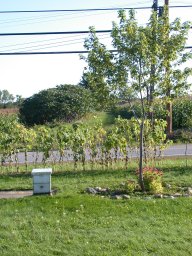
Terrestrial Isopod Terrarium Construction
| The following information will guide you through the process of making a small terrarium for terrestrial isopods. Most of what you will do is general for most terraria and can be found in many places on and off the web. Some of the steps will be specific for isopods. |
|
Materials: Pea size gravel such as you might find for an aquarium. You can substitute the styrofoam peanuts used for packing. Use a sphagum moss layer between the soil and the peanuts or gravel. Well composted soil. Commercial potting soil can be used but it is usually sterilized and may not contain material that the isopods can consume and bacteria which will break down organic waste. You may need to add some soil from an area in your lawn that has not been treated with pesticides to inoculate commercial potting soil. Clear container with a lid. A flat surface on at least one side will help in observing and photographing the isopods. Any clear container can be used but a 5 or 10 gallon aquarium is recommended. Bark or some other flat material to provide hiding places for the isopods. Rocks will work but increases that chance of breaking the glass. Leaf litter from local species. I use deciduous tree sources such as maple. I have not tried evergreen sources. The acceptability of evergreen litter could be a project for a class to attemp. Procedure: Place the pea stone in the bottom of the container. A one inch layer will be enough. This will act as a moisture reservoir and water reservoir. Keep the water level constant in the stone and there should be no problem with dehydration of the animals. (If your compost material is moist, you can add water at this point to slightly below the stone surface). Add a thin layer of fibrous peat moss on top. Just enough to prevent most of the soil from dropping into the stone layer. Next place the composted soil on the pea stone. This will provide a substrate for the isopods and other microorganisms that will help balance your terrarium and break down organic waste. The leaf litter and hiding places are next. The isopods will eat the litter. They will eat a variety of plant items but leaf litter is the easiest to find as a start. You can experiment with other materials as you find out more about the animals. I also add a piece of egg shell broken into small pieces in the container. This provides an extra source of calcium which they may need for molting. The material for hiding places is used to provide a place that will shelter the isopods but also make it easy to locate them when needed. You can place food material in a limited area at one end of a container and the shelter at the other. This will encourage more activity forobservation. Pour water through the soil and allow it to drain into the stone. Do this gradually so as not to get too much water . If you have too much, you can let the container sit in a sunny area until some of the water evaporates. Let the system cool in its final location before adding the organisms. If the compost is already moist, you can add the water to the stone before you put the other material in. Place 10 or more isopods in the terrarium. There are several species of terrestrial isopods that you can try in your terrarium. In most cases you will be able to find them in your yard under objects such as flower pots, stones, boards and fallen tree limbs. Mixing species may result in one species out competing the others. That will let you know which is best adapted for the environment you have created. Put the lid on loosely so air and moisture can circulate. Place the terrarium in a place that does not get direct sunlight. Isopods avoid light so placing the container in a poorly lighted area will encourage them to show some activity during the day. They are most active in the dark. You can add small amounts of other vegetable material but you must be careful with humidity. Too much moisture can kill the animals as well as too little moisture. Maintain the temperature between 60F and 70F. They can tolerate some fluctuation but too much heat will be lethal. If mold grows on the food, replace the food with fresh material and allow for more air circulation. With some variation, this procedure can be adapted for other organisms kept for observation and projects. |
Page updated 02/11/2006